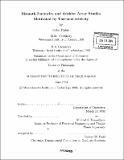| dc.contributor.advisor | Mildred S. Dresselhaus. | en_US |
| dc.contributor.author | Rabin, Oded, 1974- | en_US |
| dc.contributor.other | Massachusetts Institute of Technology. Dept. of Chemistry. | en_US |
| dc.date.accessioned | 2005-06-02T18:27:22Z | |
| dc.date.available | 2005-06-02T18:27:22Z | |
| dc.date.copyright | 2004 | en_US |
| dc.date.issued | 2004 | en_US |
| dc.identifier.uri | http://hdl.handle.net/1721.1/17738 | |
| dc.description | Thesis (Ph. D.)--Massachusetts Institute of Technology, Dept. of Chemistry, 2004. | en_US |
| dc.description | Vita. | en_US |
| dc.description | Includes bibliographical references (p. 187-200). | en_US |
| dc.description.abstract | Porous anodic alumina (PAA) films were utilized to template the fabrication of nanostructures of bismuth, antimony and bismuth-antimony alloys. The cylindrical template pores were used to synthesize nanowires by electrochemical methods. The porous surface of the template was used as a substrate for the e-beam deposition of antidot array thin films. Electrical transport measurements in bismuth nanowire arrays embedded in the templates were demonstrated to be highly sensitive to structural imperfections. Thin film studies compared the weak anti-localization effect in bismuth films with antidot array morphology versus continuous films. It is shown that the antidot array makes the weak anti-localization effect more pronounced in magnetoresistance measurements, and allows for a more detailed study of carrier scattering mechanisms in thin films. A new process is presented for the fabrication of PAA templates on rigid substrates. The substrate provides mechanical support for the generation of crack-free PAA films over areas of tens of cm2, while electrically-conducting substrates can serve as back-electrodes for the electrochemical growth of nanowires and for their electrical characterization. Various processing challenges were solved, including the deposition of thick aluminum films, the control over the adhesion between the layers of the structure, and the removal of the alumina barrier-layer at the interface between the porous film and the substrate. The use of the substrate to achieve non-planar and patterned PAA films is demonstrated. | en_US |
| dc.description.abstract | (cont.) A model is constructed to calculate the thermoelectric figure-of-merit Z of bismuth- antimony alloy nanowires as a function of diameter, composition, and carrier density. In this model, the band structure of the alloy in bulk form is modified by the quantization of k-space in the two dimensions perpendicular to the nanowire main-axis. Boltzmann's transport equations are solved with this one-dimensional band structure. The model predicts an enhancement in Z in alloy nanowires compared to the alloys in bulk form and to bismuth nanowires. The enhancement, which was found to be non- monotonic i diameter-composition space, was related to shifts in the populations and energies of the different carrier pockets. | en_US |
| dc.description.statementofresponsibility | by Oded Rabin. | en_US |
| dc.format.extent | 200, [2] p. | en_US |
| dc.format.extent | 8382985 bytes | |
| dc.format.extent | 8382791 bytes | |
| dc.format.mimetype | application/pdf | |
| dc.format.mimetype | application/pdf | |
| dc.language.iso | eng | en_US |
| dc.publisher | Massachusetts Institute of Technology | en_US |
| dc.rights | M.I.T. theses are protected by copyright. They may be viewed from this source for any purpose, but reproduction or distribution in any format is prohibited without written permission. See provided URL for inquiries about permission. | en_US |
| dc.rights.uri | http://dspace.mit.edu/handle/1721.1/7582 | |
| dc.subject | Chemistry. | en_US |
| dc.title | Bismuth nanowire and antidot array studies motivated by thermoelectricity | en_US |
| dc.type | Thesis | en_US |
| dc.description.degree | Ph.D. | en_US |
| dc.contributor.department | Massachusetts Institute of Technology. Department of Chemistry | |
| dc.identifier.oclc | 56481081 | en_US |
